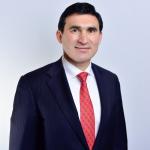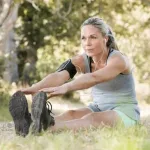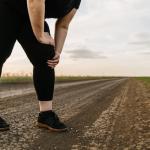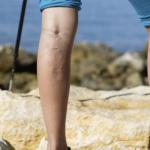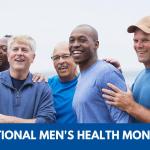
“Well, yes, my legs ache at the end of the day and are a bit swollen, doesn’t that happen to everyone?” Although some people are aware they have chronic venous insufficiency (CVI), also known as varicose vein disease, many live with the signs and symptoms every day, unaware.
Let’s talk about common signs and symptoms of vein disease:
Signs are what you see. Common signs of vein disease are:
- Spider veins – small, purple, pink, or red veins which can be found on your legs, face, and chest.
- Varicose veins – these are the large, ropey veins that can be found anywhere on the legs.
- Swelling – swelling around the legs and ankles can be caused by several factors but varicose vein disease is a common reason.
- Skin changes – often misunderstood as a dermatological issue, skin changes, especially in the ankle to calf area, known as the “gaiter” area are commonly from CVI.
- Venous ulcers – these are seen in the advanced stages of CVI. Due to poor circulation, the skin begins to break down. Venous ulcers tend to form in the ankle region.
Symptoms are what you feel. Common symptoms of vein disease are:
- Heaviness/tiredness – most people who have lived with vein disease for years believe it is “normal” for your legs to feel heavy and tired at the end of the day, after all, this is what they feel.
- Leg aching, pain, cramping – Often, patients will blame a new workout routine, taking a walk that was “too long”, and lack of potassium for this group of symptoms. Although this can be the case, these symptoms can also be caused by CVI.
- Throbbing – this is most common in patients who have visible varicose veins and usually occurs at the end of the day.
- Restlessness – Restless Leg Syndrome (RLS) has a neurologic cause but restlessness as a symptom, especially at night, is caused by inflammation, often due to chronic venous insufficiency.
- Itching – wait, what? Itching? Yes! This symptom is also often mistaken for a skin issue or allergy but can be caused by CVI.
Check out this post to learn more about why itchy veins may be a sign of vein disease.
Interestingly enough, you may have symptoms of vein disease but no signs – meaning, your legs may feel tired, achy, restless, or itchy but look great! On the other hand, you may have visible signs of vein disease such as swelling, spider veins, or even varicose veins and feel fine. This is usually because you’ve been living with vein disease for many years and have become accustomed to the symptoms. A good way to test this is to wear prescription strength compression stockings. Trust me, this is a great way to uncover the symptoms you may not realize you have.
Discover the stages of chronic venous insufficiency.
Now that you are more familiar with the signs and symptoms of varicose vein disease, or CVI, ask yourself – do I feel these symptoms on a regular basis? Do I feel better when I elevate my legs in the evening? Do I have itching, skin changes, or visible spider veins? Well, if you do, you are not alone. It is estimated that 1 in 10 men and 1 in 3 women currently suffer from chronic venous insufficiency!
Now let’s talk about common risk factors of chronic venous insufficiency
When it comes to varicose vein disease, there is often someone to thank for the gift!
- Family history of CVI – thank your mom, your dad, grandparents for passing this along to you!
- Multiparity – ladies, thank your kids! While one pregnancy puts you at a low risk for CVI, multiple pregnancies increase the risk.
Other common risk factors of chronic venous insufficiency include:
- Advanced age
- Injury
- Sedentary lifestyle – they say sitting is the new smoking and while most of us work at a computer all day, we are at risk for CVI.
Check out this post on exercises to perform at home!
So, is there a cure for vein disease?
Here is the bottom line: chronic vein disease is progressive and often genetic. Therefore, there is no cure. Do not despair, the best solution for CVI and all of its pesky signs and symptoms is….. wait for it…. treatment!
When a vein is damaged and affected by chronic venous insufficiency, it cannot be “repaired”. The way to treat varicose vein disease is to close the damaged veins, causing the blood to divert to normal, healthy veins. Think of a highway in need of repair; workers shut down the branch or portion of the road for repair and direct traffic to undamaged roads.
Remember the statistics earlier, which mentioned that 1 in 10 men and 1 in 3 women were currently suffering from CVI? Well, even more surprising, it is estimated that only 10% of them are currently receiving treatment!
Although there is no cure for chronic venous insufficiency, a myriad of state of the art, outpatient vein treatment options are available to you. Most of them are even covered by your insurance!
What to expect when you arrive to your first vein consultation
Here is what you can expect from a visit with a vein specialist, also known as a phlebologist. First, you will have a consultation appointment. During this appointment, the provider will review your symptoms, family history, risk factors, and perform a physical exam of your legs. Following this visit, if the provider believes you are suffering from chronic venous insufficiency, they will order an ultrasound to confirm. Once the detailed ultrasound is performed, the physician will be able to provide you with a personalized treatment plan which will most likely be a combination of the treatment options listed below.
Ablation procedures are the most common types of procedures used to close diseased veins. They are categorized based on the method used for closure:
- Thermal Ablation: using heat to damage the vein walls which then collapse onto themselves.
- Adhesive Ablation: using glue to shut the vein down
- Chemical Ablation: using a chemical/medication which is foamed, to damage and then collapse the vein walls. This is also known as sclerotherapy.
All these procedures can be performed in the office, with visits lasting 15-30 minutes. There is essentially no downtime as you can return to work and most normal activities right away.
So, what are you waiting for? Schedule a consultation today and learn more about how we can help!
Interested in reading more about chronic venous insufficiency? Explore our collection of topics.
-
- Risk Factors of Chronic Venous Insufficiency (CVI)
Medically Reviewed By:
Dr. Yan Katsnelson is a philanthropist, business owner, and highly skilled cardiac surgeon. He is the Founder and CEO of USA Vein Clinics, which is part of USA Clinics Group, the parent company of USA Fibroid Centers, USA Vascular Centers, and USA Oncology Centers, with more than 100 facilities nationwide. Dr. Yan has established himself as a strong advocate for accessibility and affordability of the most advanced medical care close to home. His mission is to create a positive experience for each patient with compassionate, personalized, and expert care.


